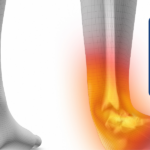
Ankle instability happens when the outside part of the ankle constantly “gives out” when putting weight it, especially when you’re running or walking on uneven surfaces. It can even happen when you’re standing. People with ankle instability often complain that the ankle feels wobbly or unstable. Because the condition is reoccurring, it is also known as chronic ankle instability.
What is the Cause?
Chronic ankle instability is usually caused by an ankle sprain that has not healed properly. During a sprain, the ligaments in your ankle may have been stretched or torn, and when they healed it resulted in weaker and “stretched out” ligaments. Individuals who participate in activities that involve the ankle, such as ballet and gymnastics or high-intensity sports like basketball or football, are at higher risk for chronic ankle instability. Those who suffer from repeated ankle sprains are also at risk for ankle instability.
What are the symptoms?
A common symptom of ankle instability is the feeling of the ankle ready to give way. This may be heightened when walking on uneven ground or when wearing high heels. The instability may also be accompanied by pain on the outside of the ankle. Sometimes this pain is intense, and other times it may be a dull ache. Some patients also experience tenderness to the touch, stiffness, and swelling. You may occasionally “tweak” your ankle from mild activities like walking. By taking a close look at how you are walking and taking your steps, you may also notice that your ankle tends to roll or lean towards one side. Though this may be due to under or over-pronation, it can also be due to the weak ligaments surrounding your ankle. People with chronically unstable ankles will often complain of sore ankles after working out.
What is the treatment?
REST
Rest. Rest may be one of the most difficult things to do as it is difficult for many people to take a break from the activities they enjoy doing. However, rest gives your body time to recover and let the ligaments have a break in terms of supporting your body. If your ankles are sore, take a few days off. If there is mild to moderate pain, it may be beneficial to take a week or two off.
ICE
Cold therapy is a form of pain relief for many injuries. By applying a cold compress or ice pack to your ankle for 10 minutes at a time 2-3x a day, you will be able to help reduce any swelling or inflammation which can lead to pain relief.
COMPRESS
Compression is important as it helps prevent swelling in the area. Try wrapping the ankle with the elastic wrap or do double-duty by using a compression ice wrap that both compresses and applies cold therapy like the DuraSoft Ankle Ice Wrap.
ANTI-INFLAMMATORY
Anti-inflammatory medications such as ibuprofen or aspirin are often taken if the patient is experiencing pain, tenderness or swelling.




